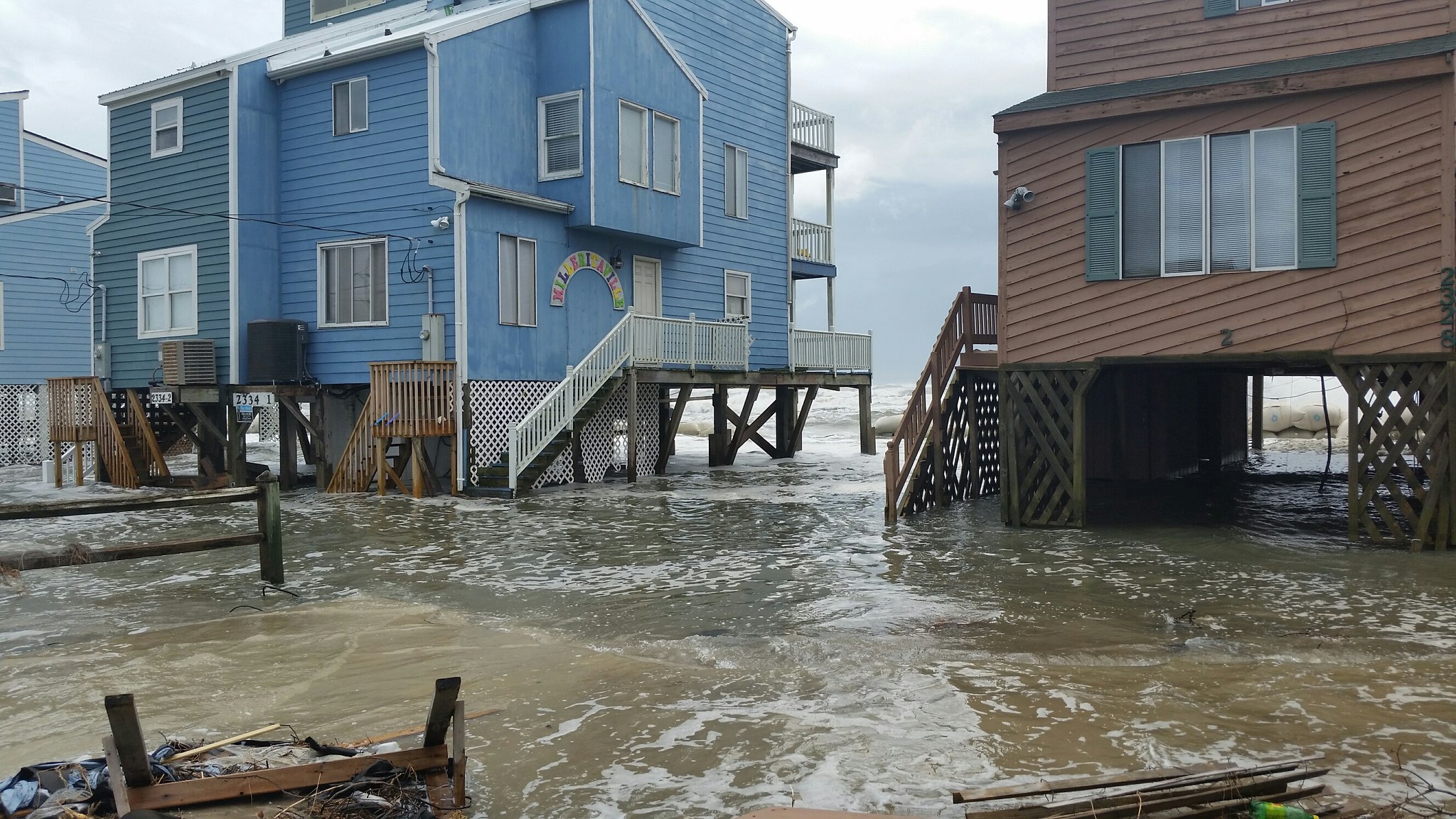Can Law Adapt to Meet the Climate Crisis?
Addressing the legal crisis lurking within the climate crisis.

Published by The Lawfare Institute
in Cooperation With

Editor’s Note: This piece has been adapted from a forthcoming article in the Stanford Law Review.
On the North Carolina Outer Banks, homes are collapsing into the Atlantic. Along the Louisiana bayou, whole communities are being swallowed by the sea. Tragically, Americans are choosing to move to coastal barrier islands and the wildland-urban interface (WUI), favoring climate-exposed locations over safer communities.
The underlying culprit is climate change. And the situation is exacerbated by existing laws, statutes, and doctrines that hide climate risk, incentivize risk-taking. These laws, statutes, and doctrines have failed to adapt and keep pace with our climate-destabilized future.
In sum, we have a legal crisis lurking within the climate crisis.
Climate Adaptation Tools Thwarted by Outdated Legal Doctrines
As I discuss below, several statutes, legal doctrines, and policies may have worked for a stable “Earth 1.0.” But they are proving unworkable for our climate-destabilized “Earth 2.0.” This legal inertia thwarts innovative adaptation action. It may already be having a chilling effect on forward-looking adaptation efforts. Just as communities must take action to avert climate disaster, laws designed for a more stable time must adapt to meet the climate moment.
As climate change destabilizes the physical environment, governments have just four core adaptation strategies at their disposal: resistance, accommodation, deliberate disinvestment, and managed retreat. Each one quickly confronts legal and fiscal realities.
First, choosing the resistance strategy—such as building sea walls or “armoring” the shoreline—may harm adjacent properties and create legal liability under existing tort or property law. After all, the floodwater must go somewhere. And the government cannot force private property owners to upgrade their existing property without running afoul of the Fifth Amendment’s Takings Clause. A government’s physical invasion of private property—however small—triggers the Takings Clause. This requires “just compensation” to be paid from the locality to the affected private property owner. A flurry of takings claims will quickly drain government coffers. We cannot resist our way out of the climate crisis.
The Army Corps of Engineers has proposed plans to armor the entire island of Manhattan—at an extraordinary cost range of $52-$119 billion. Beyond the aesthetic issues associated with such a massive project, the water could harm adjacent shoreline communities and cause an indirect taking—a concept first articulated more than 150 years ago. The U.S. government constructed a dam that flooded a citizen’s property, resulting in a Fifth Amendment violation. That $52 billion price tag for construction may be just the beginning as litigation is sure to follow.
Second, choosing the accommodation strategy—such as passing sensible, climate-informed coastal regulations—may run afoul of the regulatory takings doctrine. This legal doctrine emerged 100 years ago during a far more stable physical environment. Today, some localities require that properties along coastal barrier islands elevate their structures. Some are turning to no-build provisions that would prohibit coastal construction on certain barrier islands along the coast. But the accommodation strategy could trigger a regulatory takings challenge. This could result in a city, state, or locality having to compensate the private property owner for “taking” the private property. This will be no small sum: Zillow estimates that climate change will place 3.4 million homes worth $1.75 trillion at increased flood risk by the end of this century. Governments simply can’t afford to accommodate our way out of the climate crisis.
Third, several communities in low-lying parts of Florida and Louisiana are choosing the disinvestment strategy, refusing to maintain roads and infrastructure in coastal communities. For example, a county in Florida refused to maintain a key coastal road, citing the expense associated with repairs to a road vulnerable to climate change. Wealthy homeowners sued the county, claiming that it refused to follow the requisite abandonment procedures. The court found that the county must provide a “reasonable level of maintenance that affords meaningful access, unless or until the County formally abandons the road” (emphasis added). The upshot: There is no free lunch in our climate choices. Deliberate disinvestment and inaction may impose governmental liability, and any attempts to abandon coastal roads will be closely scrutinized.
But being too proactive in taking adaptation measures has its own challenges, even beyond the initial fiscal investment. For example, Miami is on track to spend $500 million on climate adaptation measures, an enormous investment that will be closely watched—particularly if these adaptation measures fail or go awry. As a general matter, governments are not liable for failure to provide essential services. But some courts have found that the failure to maintain existing city services creates liability. And the Army Corps of Engineers was sued by plaintiffs in the lower Ninth Ward of New Orleans on an analogous theory. They argued that the government was liable for damage to the property because the Army failed to maintain a levee system protecting New Orleans.
While this suit was ultimately unsuccessful, it showcases that climate change-driven extreme weather events will call into question the adequacy of existing adaptation measures. These decisions will be closely scrutinized. Somewhat paradoxically, Miami’s investment may result in taking on greater legal duties owed if something goes awry. Governments at all levels must walk a legal tightrope between action and inaction.
Finally, choosing the managed retreat strategy—systematically moving people out of harm’s way prior to disaster striking—may appear to be a wise choice for certain coastal communities. But this is enormously expensive and difficult to scale—witness the $25 million price tag for ongoing efforts to move small Native American communities decimated by slow-onset sea level rise and other climate impacts. And truly involuntary retreat must wrestle with eminent domain prohibitions and the dark history of forced migration in the United States and elsewhere.
What’s left? Unmanaged retreat—the displacement of people following a natural disaster. Unmanaged retreat is ad hoc, reactive, disjointed, and deeply inequitable. In 2022, the U.S. Census estimated that more than 3 million adults were forced to evacuate their homes in the past year because of a natural disaster. That’s 1.4 percent of the U.S. adult population. While many of these displacements were short term, the impact is staggering. Roughly 16 percent of the displaced adults never returned home, and 12 percent found themselves displaced for more than six months. In the absence of a national climate adaptation plan, disaster strategy has emerged as our default national adaptation strategy.
Existing Laws Incentivize Climate Risk-Taking
Beyond these adaptation strategies, existing laws obfuscate and even incentivize climate risk-taking. The taxpayer-funded National Flood Insurance Program, for example, underwrites construction in climate-exposed flood zones. Meanwhile, state and local real estate laws often hide flood risk. In 21 states, home sellers are not required to notify prospective buyers that the home is located in a flood zone. The federal Privacy Act protects prior flood claims as a protected “record.” Remarkably, prospective used car buyers have more access to critical flood information than prospective homebuyers—does this make any sense?
An Emerging Legal Destabilization?
Thankfully, some nascent efforts underway at the local, state, and federal levels address this growing need for legal adaptation. Congress has taken steps to reform the Stafford Act through increased pre-disaster mitigation measures. Proposed FEMA flood maps now take into account future climate projections, but the increase in insurance rates has already sparked a flurry of lawsuits. New York’s legislature just passed a law to mandate flood disclosure information prior to a new home purchase; that bill just landed on Gov. Kathy Hochul’s desk and is ready for signature.
And a piece of federal legislation was recently proposed—the National Climate Adaptation and Resilience Strategy Act. This requires the appointment of a chief resilience officer to direct national resilience and adaptation efforts across the United States.
While the U.S. Constitution is nearly impossible to amend at this time, some enterprising plaintiffs have rediscovered existing environmental protections within state constitutions. Last week, a judge heard arguments in a lawsuit filed by 16 youth plaintiffs against the state of Montana for violating a constitutional provision requiring a “healthful environment” for all Montana citizens.
Despite these attempts to update and transform laws, doctrines, and policies, climate change continues to outpace these efforts The best-laid plans may well be thwarted by a legal architecture inadequate for the climate-driven physical destabilization. Whether law can adapt to meet the climate moment remains to be seen.


.jpg?sfvrsn=90a0cdc0_3)

